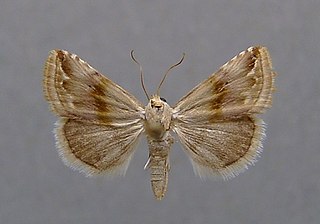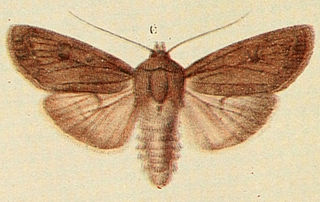
Hebomoia glaucippe, the great orange-tip, is a butterfly belonging to the family Pieridae, that is the yellows and whites. It is found in the Indomalayan realm and Wallacea.

Colotis etrida, the little orange tip, is a species of butterfly in the family Pieridae. It is native to India, Sri Lanka and Pakistan.

Cepora nadina, the lesser gull, is a small to medium-sized butterfly of the family Pieridae, that is, the yellows and whites. The species was first described by Hippolyte Lucas in 1852. It is native to Sri Lanka, India, Myanmar, Hainan, and southeast Asia.

Appias indra, the plain puffin, is a small butterfly of the family Pieridae, that is, the yellows and whites, which is found in south and southeast Asia.

Appias libythea, the striped albatross, is a small butterfly of the family Pieridae, that is, the yellows and whites, which is found in south and southeast Asia.
Oxylechia is a genus of moth in the family Gelechiidae. It contains the species Oxylechia confirmata, which is found in Colombia.

Mesapamea secalis, the common rustic, is a moth of the family Noctuidae. The species was first described by Carl Linnaeus in his 1758 10th edition of Systema Naturae. It is found in Europe, north-west Africa, Turkey and northern Iran.

Amanita nothofagi is a species of fungus in the family Amanitaceae. Endemic to New Zealand, the species was first described by mycologist Greta Stevenson in 1962. The fruit bodies have dark brown caps that are up to 13 cm (5.1 in) in diameter and covered with patches of soft greyish-brown scales or warts. The gills underneath the cap are crowded together, free from attachment to the stem, and white, becoming tinged with yellow in age. The stem of the mushroom is 4–14 cm (1.6–5.5 in) long by 0.5–2.5 cm (0.2–1.0 in) thick, and has a ring. The spore print is white, and individual spores are spherical to ellipsoid, measuring 7.5–9 by 7.5–9 micrometres. The mushroom may be confused with another New Zealand species, A. australis, but can be distinguished by certain characteristics. Amanita nothofagi is a mycorrhizal species, and grows in association with native New Zealand trees such as Southern Beech.

Eublemma ostrina, the purple marbled, is a moth of the family Erebidae. The species was first described by Jacob Hübner in 1808. It is mainly found in central and southern Europe, and further east, but is also a scarce migrant in the United Kingdom, where it is mainly found along the south coast.

Izatha apodoxa is a moth of the family Oecophoridae. It is endemic to New Zealand, where it is known from scattered localities in the southern North Island. This species is variable in appearance and comes in two forms, a grey form and a black and white form. In the grey form it is very similar in appearance to I. notodoxa and in the black and white form to I. katadiktya. At present the larvae and biology of this species is unknown.

The Scarce Arches is a moth of the family Noctuidae. It is found in central and eastern Europe and in southern Scandinavia. north Germany, Russia including the Ural Mountains, west and east Turkestan. It is not known to breed in Britain, occurring only as a migrant.
Tonica argessa is a moth in the family Depressariidae. It was described by Alexey Diakonoff in 1967. It is found on Luzon in the Philippines.
Agonopterix rubristricta is a moth in the family Depressariidae. It was described by Walsingham in 1912. It is found in Guatemala.
Sesquiluna albilunata is a moth in the family Endromidae first described by George Hampson in 1910. It is found in Assam, India.
Hypatima orthostathma is a moth in the family Gelechiidae. It was described by Edward Meyrick in 1921. It is found in Australia, where it has been recorded from Queensland.
Aristotelia hieroglyphica is a moth of the family Gelechiidae. It was described by Walsingham in 1909. It is found in Mexico (Tabasco).
Ornativalva heligmatodes is a moth of the family Gelechiidae. It was described by Walsingham in 1904. It is found in Algeria and Tunisia.
Ptocheuusa scholastica is a moth of the family Gelechiidae. It was described by Thomas de Grey, 6th Baron Walsingham in 1903. It is found in Spain.
Psittacastis stigmaphylli is a moth in the family Depressariidae. It was described by Lord Walsingham in 1912. It is found on Jamaica.
Antaeotricha discolor is a moth in the family Depressariidae. It was described by Lord Walsingham in 1912. It is found in Mexico (Guerrero) and Guatemala.









